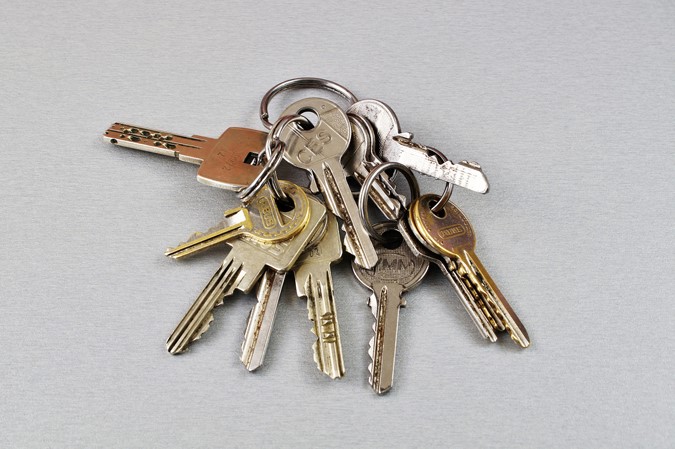Finally, SHTF has occurred. But this doesn’t worry me, because I have the skills to cope with the circumstances—including one special skill that is rarely talked about and that is widely ignored. The general public doesn’t have a clue about what it is or how it works.
The sun sets, and I wait for darkness to steal over the land. When it is finally pitch-black outside, I know I can get the preps from my garage a few yards from my house without the neighbors seeing.
But wait.
Don’t I need to reach for the nearest flashlight? The answer is, “absolutely not.” Do I have to reach for my night vision goggles? Again, the answer is, “No. I do not.”
An Introduction to Echolocation
Why? I have been trained since childhood to navigate in the dark using echolocation. My skills have been finely honed to deal with what others must surely feel is a handicap. Due to my partial vision, I was not able to make as much use of this skill as most trained, totally blind people. My ex-husband, who was totally blind, could use echolocation from a distance of about 10 feet! I cannot do that, but my own skills do come into use when it turns dark and I can no longer use my partial vision.
What is echolocation? It is the ability to know that objects are in front of you without touching them. This is learned through the hearing exercises I will give you. The most important thing when learning echolocation is that you must practice every single day to be able to use it effectively. Over time—perhaps in several months or even less—you, too, can master this skill.
How to Learn Echolocation

You need only a few things to learn echolocation:
- Patience. This is perhaps the most important factor (besides the daily practice sessions) for learning this skill. It takes time for your mind and body to understand what is happening.
- A patient partner to train with. Yes, you must find a partner who can help you train for this, and who is willing to perform certain tasks I will outline. Remember, if your children have patience, they could participate and learn a new skill, too. Short sessions with them may accomplish the long-term results you desire. Again, it’s extremely important to practice this skill every day so that you will not lose the skill once you’ve acquired it. This, I suppose, is important with any useful skill.
- A very noisy, large set of keys, or another object that makes sound when dropped on the floor. The beginning phases of echolocation training develop another useful skill: being able to find any dropped object without needing to be able to see it.
I don’t know how long it took me to go through my training. It started when I was 10 years old and was led every day by a state-hired mobility instructor for the blind. Her task was to get me mobile on the streets, making safe traffic crossings possible. (The cane training that makes this possible is given to the legally blind by request through state agencies.)
When the instructor first started teaching me, I didn’t have a clue what this training was good for.
And I certainly had no idea that my own vision would decrease as I got older and developed more eye conditions than most eye doctors care to find. I have 5 different eye conditions. One is so rare that most doctors don’t know what it is. Only trained specialists found my problems. But by that point, I had all the skills necessary to cope with legal blindness. I never went through rehab, like most blind folks do, because the mobility instructor had already trained me to be more independent than most blind folks are.
6 Echolocation Training Exercises
Now, let’s get down to brass tacks and work.
Exercise #1
First, close your eyes, and be sure to keep them closed throughout this exercise. Have your friend stand about 4 feet from you and pitch those keys on the floor. Now point, without looking, to where you think the keys fell on the floor.
How did you do with this first try? Maybe okay, but not so accurately? Try again and again, until you can point to where the keys are.
This, of course, may take time. But the time is worth taking.
What if I took that trip to the garage and dropped my keys while unlocking my garage door? Would I be able to bend down and immediately pick up those keys without hesitation? Yes. To find the keys, I would start on my hands and knees. I would then make a large circle when searching and decrease the size of that circle until the keys are found!

Exercise #2
Now try dropping the keys on a smooth surface, like tiles. The keys may slide a bit, so listen. And I do mean listen and concentrate. Can you still point to where they have gone?
Exercise #3
Your next step takes more time. Have your partner stand right in front of you. Close those eyes. (No cheating!) Have your friend put their hands to the sides of your head, about one foot from your ears, with flat palms pointed inward. Then, have them very slowly decrease this distance until you say, ” I hear something!” When trained, most say this sounds like a sort of lowering of pitch. The skill must be practiced every day so you can adjust to this type of hearing. Next, have your friend put their hands in front of your face. Can you “hear” your friend’s hands or tell where their hands are without looking to see them?
Exercise #4
The next exercise is more lethal. It might take weeks or months to master, but once you have the previous skill down, you are ready to try it out. One caution: Do not use echolocation while going down stairs. It does not work well. This is why the blind need canes to prevent them from falling down steps. And this is why I have a dog who tells me when steps are present. She stops in her harness to let me know this.
Once you are trained, going upstairs will give you a sensation of something large, either a wall or stairs, in front of you. I know that most cannot “hear” individual steps, but rather have a sense as I do that something is different from that wall. While younger, I frequently ran up and down stairs using railings. This skill can be used in buildings where you have no idea of layout, where corridors are, or where furniture is placed. In the darkness, blind people can find where this is through several methods. Echolocation is one of these, and at the end of an article I will tell you other skills that keep folks safe in the darkness.
Carefully go around your house. Yes, you may hit your knees on that low coffee table. Wood furniture sometimes is harder to “hear” than stuffed couches or chairs. Some blind folks make a sound so they can hear the echo coming back to locate objects. I do not do this. It looks odd to others, and it can be seen by the public as a bad habit of the blind. I have other, not so obvious, methods. I use an electronic tool that is sonar for the blind. I bought it many years ago, and it operates via vibration on my hands when an object is seen by the device.
Meanwhile, if you made it through your home without looking, congratulations! The next step is taking yourself outside into your yard where it’s safe to make mistakes.
Exercise #5
Now, let’s cover some other methods to keep you safe outside and inside, so you won’t have as many bumps and bruises while you learn to use echolocation.
First, to protect your lower body, place both hands at stomach level. Turn your palms outwards away from you so your fingers point to the ground. You are now protected in your lower half. Your hands will hit a low object before the rest of you does.
Now take either arm and turn your palm toward you. With the back of your hand facing away from you, cross your hand to the opposite shoulder at about chest height. In this way your arm covers the upper body and your fingers are protected because they cannot be bent backwards.
Combine both lower body and upper body techniques when moving around your yard with eyes shut! One hand does upper body while the other hand takes care of lower-body protection.
Exercise #6
Next, why not try using your favorite hiking stick as a tool for moving in the dark? When walking, your right foot goes forward while the stick goes to the left. Reverse this when your left foot goes forward so that the stick goes to the right. You may tap, using echolocation this way, or swing that stick back and forth on level surfaces or pavement. Sliding your stick on the ground will keep you more silent, of course! Remember to listen for overheads like tree branches and other objects that may be in your way.
You will not be ready to take yourself out in the darkness in less familiar spaces until all of the above steps are accomplished. Moving in the darkness is a skill. Not all of us have the cash for “night vision appliances” to light up our way in the dark.
What Can You Do in the Dark?
What can you do in the darkness? I recall cooking in the dark after a hurricane and thinking I had a lot of advantages over fully sighted folks, who must have light to do anything. Well-trained blind folks can cook, clean, and do most of the tasks you think require sight, yet do not.
I live with no useful vision every day, but can do everything except drive a car. This is through practicing and a real determination to conquer what most see as a disability to be pitied. It is not. If the legally blind are trained correctly, I assure you they live a quite normal life. When younger, I learned how to ride a bike, ride horses, sail a boat, ski, and navigate a shoreline when swimming in the ocean—all without vision.
I have hiked the White Mountains in New Hampshire, and many other hikes into the woods using only my skills. And I’ve hiked all over the United States, alone with my guide dogs, with little help from sighted folks, except the usual questions for directions to get somewhere.
Sightlessness is, at worst, an inconvenience.
In addition, bugging out may become less of a problem if you can navigate in the darkness. Hone your sense of touch until your hands can replace vision. I do all tasks using my hands as my eyes. They make a great replacement, once the skills are perfected.
Additional Strategies for Thriving in the Dark
In addition to echolocation, I use several devices to conquer my disability. The Miniguide is a device that vibrates when objects are encountered. It is so accurate that I am not allowed to use it during guide dog training, as dogs must be trained to do some of those types of tasks (e.g., stopping for cars and obstructions on the streets, moving through aisles in stores, and other tasks). I still use the Miniguide with my dog. When unexpected objects are in my way, I use it to trace the object with vibrations on my hand and may actually determine what the object is before touching it.
Next, I use a talking money identifier. I never have to ask what denomination the bill is. I use a talking scanner to identify groceries on my shelf, and braille recipe books when cooking. There are so many useful devices. But when SHTF, I may not have batteries. So I fall back on my skills.
Lastly, use common sense when trying to train for echolocation. Your safety is at stake. Practicing will help you avoid some of the falls that might otherwise result in bangs on objects you do not expect. Safety is a priority. Good luck in your training!
How to Learn More
If you are interested in learning how to do more without having to rely on vision, I encourage you to seek out a rehabilitation teacher in your area.
I am an ex-social worker for the elderly blind. Years ago, I taught the skills of daily living—such as cooking, cleaning, and grooming—to clients who had become legally blind (measuring 20/200 or less).
Eye doctors are required by law to report anyone they diagnose as legally blind to the state. I was working at the state agency to help clients become more independent. I gave up that job due to the fact that my rare disability was literally killing me, and I was advised by a team of doctors to give up the job to save my life.
But I like sharing skills that are useful to others. If you have questions while you learn echolocation, feel free to pass them on to me by leaving a comment below.
_______________________________
The Grow Network is a participant in the Amazon Services LLC Associates Program, an affiliate program designed to provide a means for our team to earn fees for recommending our favorite products! We may earn a small commission, at no additional cost to you, should you purchase an item after clicking one of our links. Thanks for supporting TGN!
Karen Bailey grew up on a small farm, where she helped garden and raise goats. Visually impaired herself, Karen has served as a social worker and rehabilitation teacher for the blind. Today, the Indiana resident works as a musician and artist, keeps an organic vegetable garden, enjoys researching old-time cooking and gardening methods, reads constantly, and loves taking long walks with her faithful Labrador guide dog.








COMMENTS(2)
What a delightful article, Karen! I served as a Board member for “World Access for the Blind” for many years, a group formed by Daniel Kish. He became blind before age 2, but taught himself to “see” by making clicking sounds with his mouth and now he travels the world working with mobility teachers, and students as well. I had never heard of the techniques you write about, though, and I am intrigued to learn of them. Thank you for sharing this!
I grew up with nearsightedness that was correctable with eyeglasses, but didn’t like the idea of always being dependent on them to go about my daily activities. Without the glasses, I could see large objects like a piece of furniture or a tree in front of me, but not something small like a dropped set of keys. As a child, I remember practicing moving around and doing things using my hearing and sense of touch, but I never knew anyone else did that or that there was a name for it. I have gotten lazy over the years, but I can still navigate and work in low light or darkness better than most people I know. I am not sure if I became aware of large objects in the dark by sound though. I always thought it was more by feel—a subtle variation in temperature as I approached, or the absence of air circulating through the object. I definitely used sound to fill a glass with water or other liquid, which I couldn’t see. I don’t know if that is what is known as the Doppler effect, but the sound frequency changes as the glass is filled, and I learned to recognize the sound of an almost full glass. Thank you for sharing your experience. This article serves as a reminder of our tremendous ability to adapt to challenging circumstances.